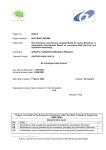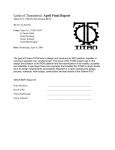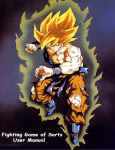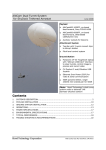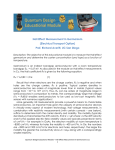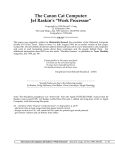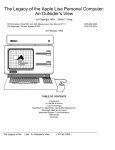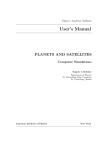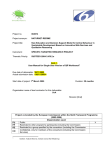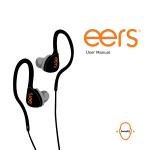Download - Light and Matter
Transcript
Instructor’s Guide for Light and Matter May 18, 2015 A reform-oriented introductory physics textbook What’s distinctive about this book is that it is reform-oriented: it emphasizes depth over breadth, it is designed to support active learning, and it never introduces a new concept with an unmotivated equation. While the reform movement has produced excellent physics textbooks for gen ed students(1) and students majoring in engineering or the physical sciences(2), no such book has been available for the type of course typically taken by life science students: a one-year algebra-based course, or a one-year course with calculus as a corequisite. This book is meant to fill that need. Another unusual feature is that both the book and its supplementary materials (in particular, an online answer checker) are designed to support a problemsolving approach focused on symbolic rather than numerical calculation. Compared to most books’ homework problems, this one’s concentrate far more heavily on problems with symbolic answers. For exampe, a student may be asked to compute a symbolic answer, then check it using the online answer checker, then interpret its meaning, and only then, as a final step, plug in numbers and produce a numerical result (which can also be checked online). Basic survival guide Here’s the most vital information you need to know if you’re using the book for the first time: (1) I’m committed to making new editions of the books as backward-compatible as possible with old editions (rather than introducing incompatibilities in order to kill off the used book market). To take advantage of this, always refer to chapter and section numbers in your syllabus, not page numbers. New homework problems will normally be added at the end, so you can safely refer to homework problems by chapter and problem number. If you have two editions in the same classroom, make sure you’re working from the older edition yourself, so that you won’t be referring to newer discussion questions or homework problems that some of your students don’t have. (2) Don’t be tempted to skip chapter 1, since it introduces the students to modes of reasoning involving ratios and proportionalities. If you skip this chap1 ter, they will complain that the homework in the later chapters is impossible. To save time, I start with ch. 2, then assign ch. 0 and 1 in later reading assignments. This works if I’m careful not to assign problems from ch. 2-3 that require knowledge of the topics in ch. 0 and 1. (3) To use the discussion questions successfully, you’ll need to give reading quizzes and explain to the students the need to read the book before coming to class, rather than using the book as a reference, which is what most students are used to doing in science classes. Resources available with this book A complete and up-to-date list of support materials is available at http://www.lightandmatter.com/area1guide.html . The answer checker, called Spotter,(9) is publicly accessible, so your students may be using it whether you know it or not. It is also possible to set things up so that students log in to accounts and you can tell who put in what answers. I require them to do this in order to get credit for the homework. My experience is that this drives them to come to my office hours for help in getting the problems right. Contents Chapters labeled * can be skipped without loss of continuity. 0 Introduction and Review 1 Scaling and Order-of-Magnitude Estimates Motion in One Dimension 2 Velocity and Relative Motion 3 Acceleration and Free Fall 4 Force and Motion 5 Analysis of Forces Motion in Three Dimensions 6 Newton’s Laws in Three Dimensions 7 Vectors 8 Vectors and Motion 9 Circular Motion 10 Gravity Conservation Laws 11 Conservation of Energy 12 Simplifying the Energy Zoo 13 Work: The Transfer of Mechanical Energy 14 Conservation of Momentum 15 Conservation of Angular Momentum 16 Thermodynamics* Vibrations and Waves 2 17 Vibrations 18 Resonance 19 Free Waves 20 Bounded Waves Relativity and electromagnetism 21 Electricity and Circuits 22 The Nonmechanical Universe 23 Relativity and Magnetism 24 Electromagnetism 25 Capacitance and Inductance* 26 The atom and E = mc2 27 General Relativity* Optics 28 The Ray Model of Light 29 Images by Reflection 30 Images, Quantitatively 31 Refraction 32 Wave Optics The Modern Revolution in Physics 33 Rules of Randomness 34 Light as a Particle 35 Matter as a Wave 36 The Atom Support for active learning The books provide two main tools for fostering active learning in the classroom: the discussion questions at the end of each section, and the hands-on activities (labeled “exercises”) at the end of each chapter. I spend more than 50% of my class time on these, and have certain methods for using them, but they can be adapted to a variety of teaching styles and methods. In a handful of cases fairly important points are introduced only through a discussion question, not in the main text, so you should make sure at least to skim all the discussion questions to see what’s in them. I sometimes do the discussion questions as a dialog between me and the class, and sometimes have the students form small groups. The former technique often allows for a higher level of discussion; in the latter approach one must be very careful to make the level of the questions easy enough so that even the weakest groups will not be demoralized. The small-group method works best with small classes. I have found that there are three keys to using active learning successfully in the classroom: (1) One must explain to the students the reason why they should read the book before coming to class. Unless it is explained to them precisely why this is crucial to the active learning techniques they will be participating in, they will 3 treat the book as a reference only, as is the universal custom among students in traditional courses despite all the usual admonitions to contrary. Reading quizzes are absolutely necessary as well. (2) Always start with activities that seem much too easy, and then move on to more difficult ones as seems appropriate. It is not hard to judge the relative difficulty of the discussion questions in advance, but the absolute level can be harder to determine. Often the questions that seem insultingly simple are surprisingly difficult. Nothing is lost by starting with easy questions, and it builds the students’ confidence. (3) It is vitally important to provide some clear method of feedback so that incorrect ideas are detected quickly and the whole class ends up understanding the concept correctly. This happens naturally if you do the questions as a dialog between you and the students, but if they are working in small groups you will need to provide some mechanism. When my students are doing small group work, I encourage them to write down their answers, so that I can look over their shoulders and see what they’re thinking. It can also be helpful to ask a particular student to repeat her explanation to the whole class. Getting psyched Attention to some psychological and social factors can also help to make the method more successful. Experience (refs (7) and (8), and my own anecdotal evidence) seems to show that it is poison for active learning if one grades on a curve in the full sense of the word, so that a certain percentage of students is guaranteed to fail and no more than a certain percentage can get A’s and B’s. Classic grading on a curve has the effect of setting the students against one another, which is antithetical to the cooperative nature of the active learning activities. This does not mean that one must use the traditional scale on which 90% is an A, 80% is a B, etc., but it does mean that the standards should be absolute rather than relative. Newtonian Mechanics Terminology and order of topics The order of topics is a little different than in most books. In keeping with the philosophy that no definition should be given without physical motivation, dynamics and kinematics are introduced in parallel rather than one after the other. The kilogram and the newton are introduced before any formal discussion of dynamics. The chapter on velocity includes a discussion of the center of mass and the principle of inertia. The chapter on acceleration introduces free fall and recaps Galileo’s dynamical argument to explain why heavier bodies fall the same way as light ones. One-dimensional kinematics and dynamics are developed before generalizing to three dimensions. However, some simple and intuitive ideas about force 4 vectors are introduced early on so that one can deal with one-dimensional motion in which there are some forces perpendicular to the line of motion which nevertheless cancel out. Vector components are introduced in a chapter by themselves, before the chapter on vectors. During the period between these chapters, one must refer to “the x component of the acceleration,” for example, rather than “the x component of the acceleration vector.” A little of the standard kinematical terminology is eliminated in order to make it seem less like the initial material on kinematics is just a matter of memorizing a long list of confusing definitions. ‘Speed’ is introduced only in a discussion question, and is not used elsewhere in the book without explanation. ‘Average velocity’ and ‘average acceleration’ are never used. The terms ‘velocity’ and ‘acceleration’ are used in the same sense as professional physicists use them, i.e. to indicate the instantaneous quantities. Th adjective ‘instantaneous’ is not used. ‘Displacement’ is not used; when the concept is needed the symbols ∆x and ∆r are employed. Chapter 0 - Introduction and Review (recommended days in class: 1) This is somewhat longer than in most books, but the self-evaluation in section 0.4 allows the better prepared student to skip a great deal of it. Many students have positive reactions to section 0.2, What is Physics?, since they may have had no exposure to the subject in their K-12 education. The discussion question in section 0.9 is extremely helpful to many students and should not be skipped. Unit conversions, discussed in this chapter, are summarized in the appendix titled “Three Essential Mathematical Skills,” which is near the end of vol. 1, after ch. 20. Chapter 1 - Scaling and Order-of-Magnitude Estimates (recommended days in class: 1) Don’t be tempted to skip this chapter! Nearly all students at this level are very weak on ratios and proportionalities, forms of reasoning that permeate the rest of the book both in the main text and the homework problems. Before reading this chapter, very few of them can, for example, figure out how many cubic centimeters are in a cubic meter, which indicates that they have never thoroughly absorbed the meaning of symbols like x2 and x3 . Without being exposed to the models of reasoning in this chapter, they will be likely to complain that many of the homework problems in later chapters are “impossible” because “there’s not enough information given.” This topic is summarized in the appendix titled “Three Essential Mathematical Skills,” which is near the end of vol. 1, after ch. 20. As discussed by Arons,(3) it is also extremely common to find that students do not understand the distinction between area and volume, and do not under5 stand their operational definitions. This problem is a significant part of the the difficulty many students have with order of magnitude estimates, as well as with many definitions that explicitly involve area or volume. Exercise 1A forces the students to apply the operational definitions and to confront the fact that area and volume scale differently. Chapter 2 - Velocity and Relative Motion (recommended days in class: 1) Velocity is defined graphically as the slope of the tangent line on the x − t graph. Students are universally uncomfortable with graphs, graphical calculations, and interpretation of graphs, so all the discussion questions in section 2.3 should be done in class in order to build their confidence and understanding. Some segments from wonderful PSSC Frames of Reference film are very helpful here. The film’s use of the term ‘fictitious force’ needs to be explained, since ‘fictitious’ may not be part of their vocabulary and is not used in the book. Many students have never been exposed to the concept of a limit, and if confronted by the symbol will treat it as if it represents a numerical variable. Exercise 2A can be used to help develop the concept of a limit. Chapter 3 - Acceleration and Free Fall (recommended days in class: 2) This chapter includes some kinematics (acceleration), some dynamics (free fall), and some mathematics (the area under the curve technique). Although the terms “average velocity” and “instantaneous velocity” are not introduced, the discussion questions provide various opportunities for inoculating students against some of the common pitfalls of using constant-velocity or constantacceleration equations when they don’t apply. The common difficulty with distinguishing the concepts of velocity (“how fast it goes”) and acceleration (“how fast it goes”) can be addressed in a rich variety of physical contexts, since they have already learned the principle of inertia. At this stage, most students will accept an equation such as ∆x = (1/2)a∆t2 without having the faintest idea that doubling the time interval results in four times the value of ∆x. Exercise 3A can be helpful. Chapter 4 - Force and Motion (recommended days in class: 2) The third law is postponed until the following chapter, but force is introduced as an interaction between two objects. Although the common misconceptions about the force concept are debunked explicitly in section 4.4, this is not sufficient for most students, and the discussion questions in this chapter will help to stamp out these conceptual difficulties. The discussion of noninertial frames is not easy for students, and I find the PSSC Frames of Reference film useful here. 6 It can be distressing to see in one’s FCI results how few students are willing to apply Newton’s first law as a general principle. Exercise 4A may help to break down some of their unarticulated objections to the concept. Exercise 4B properly belongs with the topics of chapter 5, but I have often used it as a lab during the first week of class, and since the experiment is referred to explicitly in chapter 5, it would probably not be terribly effective if used after they had read it. It is interesting that the majority of students, when asked to write their hypothesis, simply echo the statement in the exercise itself that the top scale will read higher and the bottom scale lower. This is probably an indication that they have not formed a complete concept of force as a numerical measure of the interaction between two objects, or perhaps that they have separate conceptual categories for forces that ‘force an object to move’ as opposed to attractions and repulsions. For this reason it is vital that one insist on seeing the students’ hypotheses before allowing them to set up the apparatus. They may be relatively unsophisticated about experimental errors at this point, and may ascribe undue significance to a 10 or 20% difference between the two forces. For this reason it is helpful to force them to state the hypothesis in the form of a numerical ratio. Chapter 5 - Analysis of Forces (recommended days in class: 2) This chapter introduces Newton’s third law, then passes to a discussion of the classification of forces as a fundamental problem of physics, and lays out the practical everyday classification scheme involving frictional forces, gravitational forces, normal forces, and so on. At the same time, the student is alerted to the fact that there is a simpler and more fundamental classification scheme at the atomic level. Traditional free-body diagrams have a tendency to cover up students’ misconceptions, since they do not depict forces as interactions between two objects. Knight(2) has developed a diagrammatical method that solves this problem, but I have simply used a table format for analyzing forces; students who have learned one method should have little trouble doing the other, and instructors who like Knight’s system can simply tell the students to work the relevant homework problems that way. Since analyzing forces is so difficult for students, it is not a good idea to assign all the homework problems in this chapter at once. It takes time to build proficiency in this vital skill. Students are virtually never willing to believe that friction is independent of surface area in a context such as car tires. Exercise 5A is a quick way to address this difficulty. Chapter 6 - Newton’s Laws in Three Dimensions (recommended days in class: 1) 7 Much of the vocabulary and technique is delayed until later so that this chapter can focus on the vital dynamical point: that a force in one direction has no effect on the components of the motion along the perpendicular axes. Chapter 7 - Vectors (recommended days in class: 2) Vector terminology, notation, and techniques are introduced. The discussion focuses on ∆r (displacement ) vectors. The chapter presents a number of techniques, including how to find a vector’s components given its magnitude and direction; finding its magnitude and direction given its components; adding vectors componentwise; and graphical addition. These techniques are summarized more compactly in the appendix titled “Three Essential Mathematical Skills,” which is near the end of vol. 1, after ch. 20. You and I visualize certain geometric figures when we add vectors analytically, but the connection between the picture and the sines and cosines is not obvious to students. For this reason, I find it helpful to have them perform a graphical addition at their desks using rulers and protractors. If you haven’t tried this in your classroom, you may be amazed at the amount of difficulty they have. Many students need explicit instruction in the use of a protractor; they need to be told, for example, that an angle is always an angle between two lines that cross, and that the intersection of the lines should go under the hole on the protractor (not at the edge). Chapter 8 - Vectors and Motion (recommended days in class: 1) This chapter focuses on the main source of difficulty for students, which is the concept of acceleration as a vector. Chapter 9 - Circular Motion (recommended days in class: 1) The terms ‘centripetal’ and ‘centrifugal’ tend to play into students’ misconceptions, and are avoided entirely. The PSSC Frames of Reference film is helpful regarding rotating frames of reference. Chapter 10 - Gravity (recommended days in class: 2) Many misconceptions about force and motion will surface again in this new context, and many of the discussion questions are focused on using the new context to take another swipe at the incorrect ideas. Apparent weightlessness can be demonstrated by dropping a leaking water bottle into a bucket, and also by swinging a bucket in an overhead circle, then 8 asking the students to predict what will happen if the bucket isn’t going fast enough over the top. The shell theorem is difficult conceptually for students. I have found exercise 10A helpful in this regard. Conservation Laws Terminology and order of topics Energy is introduced first, followed by work, which is defined as the transfer of energy by a force. Multiplying force by distance is introduced as a method for calculating work, not as the definition of work. The term “potential energy,” which causes so much misunderstanding, is avoided until the second chapter on energy, so that students can form a correct understanding of it as an energy associated with the distance between two objects. The term ‘impulse’ is not introduced, and the symbol ∆p is used instead. Chapter 11 - Conservation of Energy (recommended days in class: 1) Energy is introduced on a purely empirical basis, which I believe to be both historically and logically correct. This chapter is rather qualitative, and the selection of homework problems is limited, since the students have not yet learned how to calculate much. Lab 8 is designed to help students see the true empirical nature of the conservation laws. The concept of a nonconservative force is introduced through a qualitative example, without introducing the term formally. The point of view I’ve adopted is that energy is defined empirically and is found empirically to be conserved in all cases. Thus a book sliding to a stop on a table is simply described as converting its kinetic energy into heat, and one does not need to discuss whether kinetic friction is a conservative force. Chapter 12 - Simplifying the Energy Zoo (recommended days in class: 1) The main topic is how to systematize and classify all the forms of energy in a simple way, but in this chapter the student also learns how to calculate gravitational potential energy in the case of a uniform gravitational field. The algebra involved in the derivation of the equation for gravitational potential energy amounts to what is usually called the work-kinetic energy theorem, but work has not yet been introduced. Chapter 13 - Work: The Transfer of Mechanical Energy (recommended days in class: 1) 9 Since the order of topics is energy and then work, it is not necessary to define an explicit distinction between internal energy and energy associated with the position and motion of the center of mass. These are all just forms of energy, and multiplying force by distance is just a specific technique for calculating work in certain situations. The details of the relationship between energy transfer and F d are not of interest to most students, and are relegated to optional section 3.6, although students are alerted earlier in the chapter to the general circumstances in which energy transfer might not be the same as F d. Chapter 14 - Conservation of Momentum (recommended days in class: 2) The relationship between momentum conservation and Newton’s laws is discussed in some special cases, but conservation of momentum is introduced as a general principle that applies even to systems that cannot be described by Newton’s laws. The student has known about the special role of the center of mass on an informal basis since chapter 2 of book 1, so the main new concept is how to apply vector addition to momentum. A helpful demonstration is the one in which an elastic ball rolls down a ramp and knocks over a block of wood, but an inelastic one doesn’t tip the block over. Students are fascinated by the “Newton’s cradle” toy in which a set of ball bearings swing from a frame and knock each other back and forth. To bring home the point that kinetic energy is not a conserved quantity, you can use a wad of masking tape between two of the balls to damp the collision. Chapter 15 - Conservation of Angular Momentum (recommended days in class: 1-3) Angular momentum is introduced before torque, which is defined as the rate of transfer of angular momentum. A great deal of the typical material on rigidbody motion is omitted, and terms like “angular velocity” and so on therefore do not come up. The discussion of angular momentum in ch. 5 is restricted to motion in a plane. The generalization to three dimensions is covered briefly in section 36.2, where it is needed for the discussion of the atom. Introducing angular momentum without first discussing rigid-body kinematics and dynamics is admittedly a somewhat abstract approach, but students respond well to classroom demonstrations that build their intuition for the concept: - A student spins on a rotating stool and pulls in her arms. This can be interpreted in terms of angular momentum without the necessity for the moment of inertia concept. - A student spins a weighted bicycle wheel about a vertical axis, sits down on a rotating stool, and then flips the wheel over. - Two sealed boxes are prepared with the same mass inside but different mass distributions. Students are asked to handle the boxes and determine which is which. Although they do not possess the moment of inertia concept, they know 10 that mass farther from the axis will have to move faster when wiggled, and will also contribute more to the angular momentum due to its greater distance from the axis. - The instructor sits on a rotating stool and throws a bowling ball or basketball either straight outward or along a line that doesn’t pass through the axis of rotation. - One two-meter-long rod is prepared with a 2-kg weight at its center, and a second rod is prepared with a weight at its top. The students are asked to predict which will hit the floor first if they are released simultaneously from a small angle with respect to the vertical. Again, this is a demonstration that would often be interpreted in terms of the moment of inertia, but in the context of this book it can be successfully attacked in terms of the ratio of the two gravitational torques vis a vis the ratios of the distances from the axis and the ratios of the speeds at which the weights move. Exercise 15A strengthens students’ confidence with the torque concept. Although the main focus of the chapter is angular momentum as a conserved quantity, this is also the chapter in which the student learns how to solve statics problems in a plane, and there is a fairly broad selection of statics problems at the end of the chapter. How many class meetings you spend on this chapter will depend largely on how much experience you want your students to have with solving statics problems. Chapter 16 - Thermodynamics This chapter can be skipped if you wish. Before they get to it, students have already learned about conservation of energy, the equivalence of heat to mechanical work, and informally about the temperature scale, heat capacity, and the interpretation of thermal energy as random motion at the microscopic scale. Vibrations and Waves Terminology Angular velocity and frequency ω have not been introduced previously, and are not used here. Chapter 17 - Vibrations (recommended days in class: 1) Students often have a great deal of difficulty with the concepts of amplitude, period, frequency, and k. The may describe both frequency and amplitude as ‘how fast it goes,’ and may not be able to give a verbal description of k at all. Exercise 17 can help to cure these problems through concrete experience. 11 Chapter 18 - Resonance (recommended days in class: 1) The chapter leads off with a description of the Tacoma Narrows Bridge collapse, and watching the video is an unforgettable experience for a student. The physics of the event, however, was rather complex: a positive-feedback cycle involving patterns of turbulent air flow above and below the bridge. It is better to start with simpler examples before showing the video. A very simple and effective demonstration is to strike a pendulum with a hammer and various frequencies and observe the results below, at, and above resonance. Chapter 19 - Free Waves (recommended days in class: 1) Although I have used the excellent PSSC photos of superposition of pulses on a coil spring, students may have a hard time interpreting these. It is helpful to give a visual demonstration, for example using the device that consists of a series of parallel metal rots connected by a stiff wire. Regarding the separateness of wave motion and motion of the medium, it is helpful to mark a point on a slinky with a piece of masking tape, and then demonstrate compression pulses, expansion pulses, and transverse waves. Students are slow to relate the physical sensations of sound to frequency and amplitude. A demonstration with an oscilloscope and a microphone is a good idea. The distinction between group velocity and phase velocity is taken up in optional section 35.2. Chapter 20 - Bounded Waves (recommended days in class: 1) Although the chapter makes free use of both mechanical waves and light waves as examples, the examples with light waves are far more difficult for students, since they are outside their everyday experience. Demonstrations such as Newton’s rings are helpful, especially if the relevant phenomena have first been established with mechanical demonstrations. Relativity and Electromagnetism Terminology and order of topics Capacitors are discussed, but capacitance and the farad are relegated to optional chapter 25. Likewise solenoids are discussed but inductance and henries are in ch. 25. The terms ‘voltage’ and ‘voltage difference’ are used rather than ‘electrical potential’ and ‘potential difference.’ The field concepts are highly abstract and sophisticated, so I have deviated from the customary order of topics by putting them after circuits. There is 12 a detailed conceptual discussion of induction, but no detailed mathematical discussion. Relativity is used to introduce the existence of magnetic phenomena. The treatment is similar to the classic one in Purcell’s classic Electricity and Magnetism, but at a much lower mathematical level and with the use of semirelativistic approximations in some places to simplify the calculations. To highlight this interpretation of magnetism as a purely relativistic phenomenon, the coupling constants are notated as k and k/c2 rather than the traditional o and µo . Chapter 21 - Electricity and the Atom Many students at this level — even those who have taken a chemistry course — have never experienced static electrical phenomena. It is worthwhile to have them carry out simple hands-on experiments with sticky tape. I start by having them make general observations during class, such as verifying Newton’s third law with charged pieces of tape. Their first laboratory exercise is then a more challenging set set of activities to determine how many types of charge exist, etc; the lab manual is available through the www.lightandmatter.com web page. Although this may at first seem like third-grade science, the students usually end up finding it to be the most intellectually challenging lab they do in the course. Most demonstrations of static electric induction are small and hard for the class to see. One fairly big and visible demonstration is to lay an aluminum can on its side and attract it with a charged rod. Most students have little trouble with the concept of current, but voltage and resistance are far more subtle. Discussion question 21.5A introduce the mechanical analogy of a roller coaster, which can be brought back periodically throughout this chapter. Students tend to use charge, voltage, and current interchangeably, and many of the discussion questions are aimed at developing the distinct concepts. Exercise 21B also addresses this distinction. The qualitative questions on circuits from Arons(3) are an extremely helpful supplement to this chapter. Exercise 21C is a hands-on version of some examples of this type. Although they can often get the right answers by using a rule of thumb about the path of least resistance, this should be discouraged since it can give wrong results and tends to lead to a description of the experience of an individual electron rather than of the circuit as a whole. Chapter 22 - The Nonmechanical Universe Some simple empirical evidence (the Hafele-Keating experiment involving atomic clocks transported around the world) is given for the fact that time is not absolute, and an argument is then presented that this makes it impossible for electrical effects to propagate instantaneously. This forces us to conceive of field of force that have their own physical reality. 13 Exercise 22 provides some hands-on experience with vector addition of fields. The sea of arrows picture is the main focus, and field lines are treated as secondary. Gauss’ law is discussed in optional section 22.7, and is only developed in the case where the field is perpendicular to the surface. Instructors wishing to cover the full mathematical statement of Gauss’ law could use the excellent materials by McDermott(4-5). Chapter 23 - Relativity and Magnetism This chapter develops the Lorentz transformation and uses it to show that relativity requires the existence of magnetic interactions. In addition to my book, I also have my students read Martin Gardner’s wonderful and entertaining Relativity Simply Explained. Gardner is, however, woefully out of date on some subjects, especially cosmology. The discussion questions are aimed at the common difficulty expressed by students as, ‘are time and space really different in different frames, or does it just seem that way.’ Modern pedagogy for special relativity focuses heavily on spacetime diagrams, rather than the older algebraic style, and the geometrical approach is the one that I’ve adopted here. Two gen ed books exemplifying this approach are Mermin’s It’s About Time and Takeuchi’s Illustrated Guide to Relativity. Mermin, who has polished his presentation over the course of four decades of teaching relativity, makes the important point that most students beginning special relativity are still very weak at Galilean relativity. For this reason, I always devote half of a class period before the students read this chapter to a presentation of Galilean relativity using the same graphical conventions employed in section 23.1. I make the point that different observers disagree about whether two places are the same (no “simulplaceity”), as preparation for SR’s lack of universal simultaneity. The logical framework used here for special relativity will be unfamiliar to many instructors. Rather than taking the constancy of the speed of light as an empirical fact and then deriving the Lorentz transformation (including time dilation), I take time dilation as an empirical fact and then derive the Lorentz transformation (including the constancy of c). This is in keeping with the modern view of relativity as a description of the properties of spacetime, and of c as representing primarily a time-to-space conversion factor, rather than the speed of propagation of a certain phenomenon called “light.” Derivations of the Lorentz transformation in this style, from symmetry properties of spacetime, go back at least as far as 1910, to a paper by Ignatowsky, Phys. Zeits. 11, 972. Modern textbook presentations include Rindler, Essential Relativity: Special, General, and Cosmological, Springer-Verlag, 2nd ed., 1977, p. 51, and Morin, Introduction to Classical Mechanics, Cambridge, 1st ed., 2008, Appendix I. A derivation that is freely available online is Pal, “Nothing but Relativity,” arxiv.org/abs/physics/0302045. My goal in this treatment was to distill these somewhat forbidding algebraic derivations into a form that would be geometrical in character and as accessible to lower-division students as the more 14 traditional approach in which the speed of light is assumed. An important point in the logic is the proof that Lorentz transformations must conserve area in the x − t plane. (Note that Takeuchi treats this point incorrectly.) To understand the significance of the equal-area proof, it may be helpful to consider two doubts that could be expressed about the logic. First, the argument seems to show that the size of something, as measured by area, must stay the same under a Lorentz transformation, and it may not be immediately obvious why the argument fails if we talk about linear size instead. The length of a line segment does not stay constant under a Lorentz transformation, so if the proof also applies to length, then the proof must be fallacious. The key here is that the analysis of step 3 of process Q requires that the −v transformation act on a geometrical figure that is identical to the original one except for displacement (as allowed by property 1) and scaling (as allowed by linearity). The initial +v transformation, acting on a line segment, dosn’t just displace and scale the line segment, it also rotates it. Since it is not possible to chop up a rotated line segment into smaller segments that are not rotated, the proof fails, as it should, when applied to length rather than area. Second, we may ask what would happen if we did a Lorentz transformation corresponding to motion along the x axis, but applied the proof to an area in the y-t plane. If the proof held in this case, then again the proof would have to be erroneous, since the Lorentz transformation dilates t while leaving y alone, causing the area to expand by a factor of γ. The reason that this version of the proof also fails, as it should, is identical to the reason for the failure of the version involving the length of a line segment. The initial Lorentz transformation doesn’t carry the original rectangle in the y-t plane to another shape in the y-t plane; the new shape has been tipped into a plane that is rotated with respect to the original one. We can also make similar arguments about volume. Replaying the same proof for a unit cube in (x, y, t) coordinates, all the same steps carry through, and we find that volume is conserved under a Lorentz transformation for a velocity parallel to the x axis. Since we already know that the slices of such a cube parallel to the x-t plane have their areas preserved, it follows that a Lorentz transformation in the x direction has no effect on the y coordinate. Optional section 24.7 presents the idea of relating areas to spacetime intervals, expressed in terms of light-rectangles. This is developed at greater length in the following papers: Mermin, “Space-time intervals as light rectangles,” Amer. J. Phys. 66 (1998), no. 12, 1077; Brill and Jacobson, “Spacetime and Euclidean Geometry,” arxiv.org/abs/gr-qc/0407022; Salgado, “Visualizing proper-time in Special Relativity,” arxiv.org/abs/physics/0505134. Chapter 24 - Electromagnetism To convince the students that fields of force are real, it can be helpful to demonstrate the finite time taken for the field around a solenoid to decay. Magnetic forces can be demonstrated using a bar magnet and an old computer monitor, preferably one that has a degaussing button. Beware of ruining 15 an expensive color tube this way! After showing, for example, that an upright bar magnet attracts the beam of electrons from the right side, the students are suprised to see that it repels them from the left side; this is because they intuitively expect the bar magnet to act as a monopole. It is necessary to mark the screen with a piece of masking tape to make the slight shift in the image visible. Ampere’s law and the Biot-Savart law are omitted, and induction is described only qualitatively. The lab manual, available through the www.lightandmatter.com web page, contains a laboratory exercise in which students make qualitative and semiquantitative observations of induced electric fields. Chapter 25 - Capacitance and Inductance This chapter can be omitted without loss of continuity. Chapter 26 - The Atom and E = mc2 This is the first example most students have encountered of how one scientific model (the planetary model) replaces another (the raisin cookie model). The discussion question on numerically analyzing the results of the Rutherford experiment is time-consuming if you really make the class fill in all the reasoning, but I think it is well worth the time spent. A helpful demonstration is to provide three unmarked sources — alpha, beta, and gamma – and a counter, and ask the students to determine which source is which. Chapter 27 - General Relativity This chapter can be omitted without loss of continuity. Optics Sign conventions are eschewed in favor of setting up equations with plus and minus signs determined by graphical reasoning using ray diagrams. The student is however alerted to the use of sign conventions and the interpretation of positive and negative focal lengths. Although curved mirrors are less frequently encountered than lenses in real life, I start with curved mirrors because the ray diagrams are easier to draw, and this gives the student a fighting chance to build a conceptual understanding before encountering all the equations. Chapter 28 - The Ray Model of Light (recommended days in class: 1) Despite having been introduced to light as an electromagnetic wave in books 3 and 4, students at this point still need work on the basics of light and vision. 16 In my classes I have supplemented my own discussion questions with questions from the Project STAR survey(6). Chapter 29 - Images by reflection (recommended days in class: 1) A useful demonstration is to place a large mirror facing the class on a desk and have several students place meter sticks on the desk to point to the direction in which they see the image. Exercise 29A can be used. Chapter 30 - Images, quantitatively (recommended days in class: 1) Exercise 30A can be used. Many students have a surprisingly hard time drawing the specular reflections correctly; if the incoming ray gets closer to the normal, they may draw ther outgoing ray farther from the normal! It helps if you explicitly tell them to draw in the normal. (Working spontaneously, they may draw in the tangent to the surface, which is harder to see because it coincides so closely with the mirror’s surface.) Chapter 31 - Refraction (recommended days in class: 2) Exercise 31A can be used. Chapter 32 - Wave Optics (recommended days in class: 2) Exercise 32A, using ripple tanks, can help to make the concepts more concrete. Exercise 32B explores single-slit diffraction. The following is a listing of what the students’ data should look like. The last two columns are the amplitude and square amplitudes of the combined wave. The first minimum is near f, and the second near k. The results can be understood by seeing that the list of phases at a minimum goes through two complete cycles, so that each Huygens ripple has another one to cancel with that is half a cycle behind it. a b c d e f g relative phase ---------------------------------------------------0.00 0.06 0.11 0.14 0.14 0.13 0.10 0.06 -0.01 0.00 0.09 0.16 0.21 0.24 0.25 0.25 0.22 0.18 0.00 0.11 0.20 0.27 0.33 0.37 0.39 0.39 0.37 0.00 0.13 0.25 0.34 0.42 0.48 0.52 0.55 0.55 0.00 0.15 0.29 0.41 0.51 0.59 0.66 0.71 0.74 0.00 0.17 0.33 0.47 0.60 0.70 0.79 0.86 0.92 0.00 0.19 0.37 0.54 0.68 0.81 0.92 1.02 1.09 17 A ---8.49 7.95 6.40 4.33 2.49 1.95 2.35 A^2 ----72.06 63.22 41.02 18.74 6.21 3.80 5.53 h i j k 0.00 0.00 0.00 0.00 0.21 0.23 0.25 0.27 0.41 0.45 0.49 0.52 0.60 0.65 0.71 0.76 0.76 0.84 0.92 0.99 0.91 1.01 1.11 1.20 1.05 1.17 1.29 1.40 1.16 1.31 1.45 1.58 1.26 1.43 1.59 1.74 2.45 2.00 1.20 0.46 5.98 3.99 1.45 0.22 The Modern Revolution in Physics Chapter 33 - Rules of Randomness (recommended days in class: 2) The main concept of this chapter is statistical independence, which is counterintuitive for most gamblers and sports fans. A good demonstration is to have everyone in the class flip a coin to determine which people have ‘decayed,’ repeating until everyone has decayed. This leads naturally to the idea that there is no ‘whole life.’ Chapter 34 - Light as a Particle (recommended days in class: 2) With the advent of digital cameras and camcorders containing sensitive CCD chips, the existence of photons is no longer something that can be observed only in the physics laboratory. After introducing the evidence for photons, the book passes to a discussion of the photoelectric effect as evidence for E = hf , and the double-slit experiment, which gets straight to the heart of wave-particle duality. The approach is ahistorical, and blackbody radiation is not discussed, since it is not an intelligible way to introduce the photon to students at this level. Chapters 34 and 35 present a picture of quantum mechanics that is very symmetric: a photon is both a particle and a wave, and an electron is both a particle and a wave. There are limits to how far this symmetry can be pushed. In particular, there are fundamental limitations on the extent to which the electromagnetic field can be interpreted as a sort of wavefunction of the photon, and there are fundamental reasons why there is no classical field theory of electrons. Good discussions are given in Peierls (10), section 1.3, and in Birula (11). But these issues are far beyond anything that the typical student in this type of course is ready to absorb. They are briefly addressed, for the sake of intellectual honesty, in certain examples, footnotes, and homework problems. Chapter 35 - Matter as a Wave (recommended days in class: 1) This chapter tends to be smooth sailing, since it amounts to a trivial generalization of the preceding one. Students who have already confronted waveparticle duality have little trouble with the uncertainty principle. 18 Chapter 36 - The Atom (recommended days in class: 2) The Bohr model is avoided, since it is incorrect both conceptually and in many of its predictions. Instead, an approximate method is used for estimating the energy levels of hydrogen. Common elementary problems experienced by students include the expectation that all atoms have the same energy levels as hydrogen and failure to understand that photon energies correspond to differences in atomic energies. References (1) Hewitt, Conceptual Physics (2) Knight, Physics: A Contemporary Perspective, preliminary edition, Addison Wesley, 1997. (3) Arons, Teaching Introductory Physics, Wiley, 1996. ISBN 0-471-13707-3. (4) McDermott, Tutorials in Introductory Physics, Prentice Hall. (5) McDermott, Physics by Inquiry, Wiley. (6) Anne G. Young, Project STAR Survey: How Much Do You Know About the Nature of Light?, Harvard-Smithsonian Center for Astrophysics. Anne G. Young, Physics - Bldg. 8, Rochester Institute of Technology, POB 9887, Rochester, NY 14623-0887. (7) Sheila Tobias, They’re Not Dumb, They’re Different. (8) Eric Mazur, Peer Instruction: A User’s Manual. (9) An article describing Spotter appeared in The Physics Teacher in September 2003. Digital reprints are available at http://www.lightandmatter.com/spotter/spotter.html. 19



















